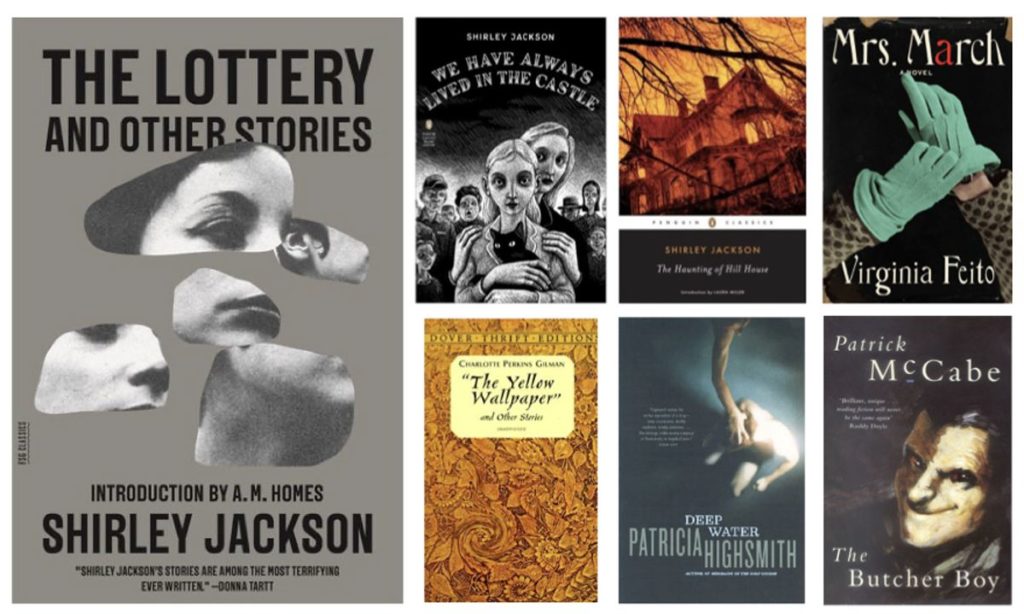It’s time for another adventure in Kate’s 6 Degrees of Separation Meme from her blog, Books Are My Favourite and Best. We are given a book to start with, and from there we free associate six books.
This month we start with “a (frightening) short story,” “The Lottery” by Shirley Jackson. This is probably the story Jackson is best known for. It appeared in The New Yorker in 1948. What I love about Shirley Jackson’s work is the way she gradually makes the reader realize that things are not always what they seem to be.
1. Another work by Shirley Jackson that has always fascinated me is We Have Always Lived in the Castle. It doesn’t take readers very long to realize that they are in the company of a very disturbed first-person narrator with Mary Katherine Blackwood.
2. With Merricat Blackwood we see a character who has been deranged for quite a while (probably all her life). In The Haunting of Hill House, another of Shirley Jackson’s works, we get to watch a character, Eleanor Vance, undergo the process of descending into madness.
3. Virginia Feito also shows us a character’s descent into madness in her recent debut novel Mrs. March. Mrs. March is the proud wife of author George March, whose latest novel is a best-seller everyone in Manhattan is gossiping about. But a casual remark about one of the novel’s characters by the shopkeeper at her favorite patisserie nudges Mrs. March over the edge into an overwhelming downward spiral of paranoia, self-doubt, and traumatic memories.
4. Charlotte Perkins Gilman’s 1892 story “The Yellow Wallpaper” provides yet another look at a woman pushed to the brink of insanity. Written by a visionary feminist as the Victoria era waned, this story features a female character constrained by her husband, a physician, whose treatment represents the era’s patriarchal notions of propriety for women.
5. So far all of our mad characters have been women. This is not surprising, given history and the literary trope of the mad woman in the attic it gave rise to. (Think Bertha Mason Rochester in Charlotte Brontë’s Jane Eyre.) However, men can be just as mentally unstable, as Patricia Highsmith aptly demonstrates in her novel Deep Water.
6. Patrick McCabe gives us another portrait of a man’s descent into madness in The Butcher Boy. Set in Ireland, the novel focuses on the mind of young Francis “Francie” Brady.
I find stories like this fascinating not just because of my interest in how fiction portrays human psychology, but also because of the skillful craftsmanship they require of their authors. Any convincing portrait of mental instability must create the feeling of chaotic, disjointed thought patterns. Yet the author must control the chaos to allow readers to understand and appreciate what is happening to the character. Anyone who can pull off this feat is a skilled writer indeed. All of the books in this list demonstrate authors at the peak of their creative talents.
© 2021 by Mary Daniels Brown


What a thought provoking chain, Mary. The human mind is fascinating, isn’t it? Particularly when it begins to buckle under strain.
I’d not read any Shirley Jackson before I read the short story for this month’s chain, and I’m interested to read more by her now. I know the names of the two you include here, and your descriptions make me think I’ll give them a go.
I haven’t yet read much of Jackson’s work, but I highly recommend both “Castle” and “Hill House,” especially if you’re interested in the topic of how fiction portrays mental illness/instability. Thanks for reading.
I love dark stories like this, too, and for a long time The Butcher Boy was my favourite novel!
Glad to hear someone besides me appreciates The Butcher Boy. I don’t see it mentioned much, but it’s quite well done. Thanks for commenting.